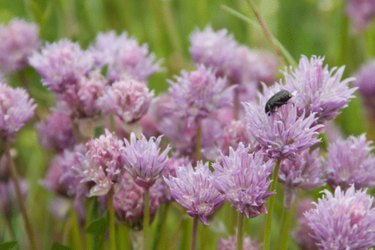
The common lilac is a deciduous shrub and a member of the Oleaceae family. This plant produces lovely blooms with purple petals and is relatively tolerant to drought. Lilacs are susceptible to infestations of many damaging insects, such as leafminers. Severe infestations of these pests often require chemical control methods to preserve the health and appearance of the plant.
Types
Video of the Day
The lilac borer is a common lilac pest that bores into the wood of the common lilac. The adult form of this pest is the clearwing moth, which is similar to a wasp. Lilac damage is produced primarily by lilac borer larvae, which feeds on the sapwood of the plant. Scale insects are another lilac pest, which damage lilacs by sucking the sap from the leaves, stems and roots of the plant. Heavy scale infestations can cause lilacs to appear unhealthy. Another damaging pest, leafmining insects cause tunneling injuries to the plant. The adult form of the lilac leafminer is a very small moth.
Video of the Day
Effects
Lilacs with infestations of boring insects, often have exit holes on the trunk and branches of the plant. Exit holes are approximately 1/4 inch in length and are most common on the lower portion of the plant. These holes are often filled with frass, which is a combination of excrement and sawdust. Lilacs with heavy infestations of the lilac borer wilt, turn brown and die from injury to the internal wood. Scale insects feed on the leaves of lilacs, which often causes leaf stippling or speckling. Lilacs with scale insects have reduced vigor and often have sooty mold. Sooty mold is a condition caused by the scale insect excreting honeydew, which causes the mold to adhere to the lilac. Leafminers produce tunneling injuries on leaf surfaces, which are blotchy or snake-like. Areas on lilacs mined by these insects dry out and die. Lilacs with leafmining insect infestations often have frass on the surface of leaves.
Cultural Controls
Since many insect infestations occur because of stress to lilacs, keep your plant watered and fertilized. Prune lilacs but avoid heavy pruning during the summer months. Boring insects may be trapped with pheromone traps placed in the garden. Scale insects are often controlled by washing your plant with a hard stream of water, two times a week. This removes scales from your lilac and helps reduce sooty mold.
Chemical Control
Insecticides for boring insect control are available at your local gardening center. Insecticides are most effective if used when lilacs are in full bloom. Scale insects are often controlled with horticultural oils, which smother the insects on contact. Apply horticultural oils in a thorough manner, as they need to coat the insects for maximum benefits. Using horticultural oils on your lilacs may also help loosen sooty mold and make it easier to remove from your plant. There are currently no chemical control methods recommended for leafmining insects in lilacs, as the injury to the plant is usually minimal.